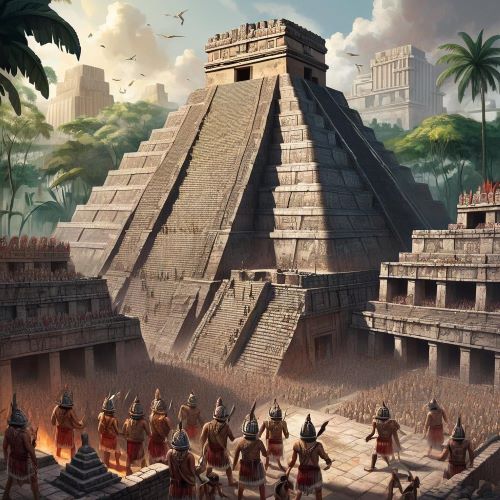Writing Research Papers: Student Guide to Global Mythology
Researching myths across cultures can feel like entering a forest of stories. Symbols, rites, and meanings appear at every turn and shift with context. Students who want a clear route through that forest need calm, practical guidance. This student’s guide to writing research papers on global mythology offers such guidance. Many learners seek reliable helpers when deadlines press and schedules become crowded. Some turn to the capstone paper writing service by Essay Market during difficult weeks. Lasting progress still depends on understanding the craft and practicing its habits. By following a friendly plan, students master research, choose engaging topics, and build arguments. They also see how mythology connects ancient Greek tales with modern urban legends across cultures. The guide also outlines research ethics that respect communities and preserve living traditions. Clear tips explain paper sections, source gathering, and traps to avoid during drafting. The process grows less scary and far more rewarding with steady, guided practice.
Understanding Global Mythology
Global mythology gathers creation stories, heroic journeys, and cautionary tales from many cultures. To frame cross-cultural studies in an academic setting, students first need clear definitions. A myth can be described as a traditional narrative that a community treats as meaningful. Literal truth matters less than shared meaning and continued use within daily life and ritual. Because myths arise everywhere, research should avoid narrow bias toward any single culture or language. Comparing themes like flood cycles or trickster figures helps reveal common patterns in human life. This approach also discourages lazy copying from summaries and rewards careful, original thought. Scholars value fresh analysis grounded in credible evidence that withstands close and fair review. A balanced starting point includes essays, folklore journals, archaeology reports, and translated epics with notes. Clear definitions early let the paper move from story details to careful scholarly interpretation.
Selecting Engaging Research Topics
Choosing a subject often delays student projects more than any other single step. A strong plan starts with broad motifs, then narrows focus to culture, time, or medium. Consider creation cycles, trickster magic, or the varied routes of heroic journeys across regions. Then narrow the lens to one group, one era, or one chosen form like film. While brainstorming topics on mythology, write concise aims that you can answer within limits. One aim might compare Māori hero Māui with Greek Prometheus across motives and consequences. Another might trace how dragon stories shift along Silk Road trade routes and borders. Scanning current conference programs on mythology can reveal trends that inspire fresh projects. Framing goals in this way turns vague interest into steady, workable research intentions. Instructors prefer topics that invite debate rather than mere description of stories and motifs. Comparing, contrasting, or tracing change across time usually earns stronger engagement and higher marks. By the end, craft one sentence that is focused, feasible, and clearly arguable.
Building a Solid Structure
Once the topic is set, the paper’s structure should be planned with care. Most academic guides divide a mythology paper into four main and familiar parts. Those parts are the introduction, the literature review, the analysis, and the conclusion with focused closing thoughts. The introduction states the research question and previews the thesis in firm terms. A concise review of prior scholarship follows, showing lines of agreement and dispute. Next comes analysis, the longest part, where evidence is examined in close, patient detail. The conclusion ties arguments back to the research aim and notes future study paths. Many instructors also expect a short methodology paragraph explaining how sources and translations were chosen. When multiple languages are involved, note translation choices that might influence your interpretation. Students who outline early usually write faster because each paragraph already has a task. To visualize flow, create a table mapping claims, sources, and notes for each section. Color-coded tabs or cards can also help keep every section aligned with the thesis.
Gathering Reliable Sources
Quality evidence turns a myth-based narrative into a serious academic work that persuades readers. Primary sources include ancient texts, oral transcripts, visual art, and archaeological artifacts from verified digs. When writing about myths, compare multiple translations whenever that option is possible and responsible. Word choices can shift meaning and tone across editions and translators across many decades. Secondary sources include peer-reviewed articles and academic essays that explain contexts and theoretical models. Digital databases like JSTOR, Project Muse, and myth indexes help speed focused searches. Printed collections remain valuable for lesser-known legends that digital platforms sometimes overlook or omit. Field interviews with storytellers can enrich cultural writing, provided ethical guidelines are followed closely. Record access dates for online materials so future readers can verify referenced versions. Obtain clear consent during interviews, and protect participants’ privacy in stored notes. While collecting data, create annotated bibliographies summarizing argument, reliability, and relevance for each source. Doing this prevents confusion later when drafting and linking quotes to supporting claims. Citation managers like Zotero can store notes and generate reference lists in required styles. These habits demonstrate sound methodology and give your project authority beyond personal fascination.
Crafting a Persuasive Thesis Statement
A thesis statement guides the reader like a steady star over dark water. For mythology writing, the thesis should present an arguable claim and a clear path of proof. Weak theses simply announce topics, such as a survey of Norse gods and rites. Stronger versions take a position that evidence can be tested within assigned limits and scope. For example, Loki’s changing portrayals mirror shifts in Scandinavian social norms and expectations. That claim can be tested with texts, images, and timelines from multiple periods. Before finalizing, apply a quick checklist for focus, support, and contribution to scholarship. Ask whether the claim fits the length and adds insight beyond common classroom clichés. A working thesis may appear after the literature review, which is normal during drafting. End with one clear sentence that unites every paragraph and guides the entire argument.
Drafting with Clarity and Flow
With an outline and thesis secure, drafting can begin with steady attention. Effective writing tips for mythology papers place clarity ahead of ornament and vague flourish. Short sentences, active verbs, and precise nouns keep reading smooth for busy instructors. Paragraphs should start with topic sentences that link each idea back to the thesis. This habit prevents detours into engaging but off-track legends and colorful, distracting side tales. Use transition phrases like on the other hand or in contrast to guide movement. When quoting sacred texts or epics, introduce each passage and explain its purpose clearly. Integrate quotations with analysis so evidence never stands apart like unexplained carved runes. Alternate between a brief summary and a close analysis to show both scale and fine-grained detail. Maintain a formal tone, yet avoid jargon you do not fully understand or control. Set small daily word goals to keep momentum during demanding weeks and crowded semesters. These routines help produce complete drafts within limits while keeping ideas connected and clear.
Revising, Proofreading, and Citing
Strong writers become stronger by revising with patience, attention, and repeated passes through drafts. After a draft rests for a day, return with a fresh perspective and careful focus. Fresh eyes catch unclear logic, thin support, or missing steps in needed reasoning. In cross-cultural mythology studies, accuracy in names and diacritical marks remains crucial and nonnegotiable. Check spellings and marks against trusted glossaries, catalogs, and style resources used by scholars. A reverse outline helps confirm whether each paragraph still advances the controlling thesis claim. Write short margin notes naming purpose, evidence, and linking back to the thesis. Proofreading comes next, including reading aloud to locate awkward rhythms and tangled phrasing. Grammar tools can help catch stray commas, but judgment still belongs to the writer. Citation review forms the final layer before submission and warrants deliberate, unhurried attention. Reference managers sometimes import mistakes, so verify each field by checking the original source. Use a style manual such as MLA or Chicago to keep formatting consistent. Accurate references avoid plagiarism and guide classmates toward further reading on studied traditions.
Avoiding Pitfalls and Succeeding
Certain errors appear so often that instructors can spot them from the doorway. The first is a summary without argument; retelling a legend never equals analysis or insight. Prevent this by returning to the thesis after each section and checking clear progress. Confirm that new material advances the claim in direct and traceable ways every time. The second trap is uneven source quality that weakens the points you need to establish. An unsigned blog without citations carries little weight against peer-reviewed research and edited collections. Time mismanagement also leads to rushed conclusions, thin analysis, and sloppy formatting throughout. Set a calendar with checkpoints for reading, drafting, and revision to distribute labor evenly. Connect ancient tales to current issues to engage readers while remaining careful and academic. Discuss climate change through flood myths to refresh the topic without abandoning rigorous methods. Share drafts with classmates or writing centers to gather feedback before grading day arrives. By avoiding these pitfalls and applying proven habits, students build projects they can showcase proudly.
Summarizing Key Takeaways
Writing research papers on myths does not demand mystical powers or rare gifts. It asks for ordered steps, steady curiosity, and respect for readers and sources. This guide showed how careful topic selection and solid structure support clear academic writing. Authoritative sources, patient revision, and accurate citations further raise quality and scholarly credibility. At every stage, a clear thesis lights the way through complex and layered legends. When students practice these moves, daunting folklore turns into persuasive and well-supported analysis. Remember the main sequence: choose an engaging aim, gather reliable data, and analyze patterns. Draft with clarity, then polish with precise citations that help others continue the study. Each phase feeds the next like chapters in one long heroic saga. Following this blueprint makes research manageable and helps fresh insight reach cross-cultural mythology studies.
No posts were found.









